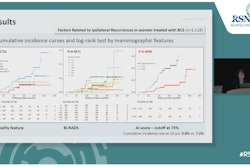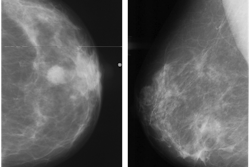The rate of late-stage breast cancers is on the rise in the U.S., according to findings published December 10 in Radiology.
This goes for women in all age groups and women who are Asian, Black, Hispanic, and Native American, according to the report written by Edward Hendrick, PhD, from the University of Colorado in Aurora and Debra Monticciolo, MD, from the Foundation for Imaging Research and Education in Temple, TX.
“Our research is showing that we are missing opportunities to diagnose disease early,” Monticciolo told AuntMinnie.com. “We’re missing them, and we really need to get women in to be screened. We need to have women, radiologists, and clinicians recognize these trends are not favorable and we have to reverse them if we’re going to save women’s lives.”
Previous studies have highlighted an increasing incidence of late-stage, metastatic breast cancer at initial presentation. While these studies suggest a greater prevalence in younger women, including those under 40 years old, the researchers noted that such trends have not been established for older women over 75 years old.
Hendrick and Monticciolo evaluated trends in late-stage breast cancer incidence. They used the latest available data from Surveillance, Epidemiology, and End Results (SEER), including data from the COVID-19 pandemic peak years of 2020 and 2021. Depending on the year, SEER contains breast cancer data for between 71 million and 80 million women.
The researchers reported the following:
- Late-stage breast cancer incidence rates at presentation increased overall for U.S. women, with an annual percentage change (APC) of 1.16% (p < 0.001) from 2004 to 2021.
- Late-stage disease increased consistently for women aged 20 to 39 years with an APC of 2.91% (p < 0.001) and for women aged 75 years or older with an APC of 1.44% (p < 0.001).
- For women aged 40 to 74 years, the late-stage breast cancer incidence rate increased with an APC of 2.10% between 2004 and 2010 (p = 0.002) and an APC of 2.73% between 2018 and 2021 (p = 0.01).
Also, the COVID-19 pandemic impacted late-stage cancer detection. The researchers wrote that this impact especially impacted older women from racial and ethnic minority groups.
The incidence of distant-stage breast cancer increased between 2004 and 2021 for the following: Asian women (APC, 2.90%; p < 0.001), Black women (0.86%; p = 0.008), and Hispanic women (1.56%; p < 0.001). Between 2004 and 2019 Native American women experienced an APC increase of 3.86% (p = 0.04).
White women meanwhile had an incident increase from 2004 to 2012 with an APC of 1.68%; (p = 0.01). However, the researchers did not observe such a trend from 2012 to 2021. Finally, Black women faced a 55% higher late-stage cancer incident rate than white women.
Hendrick and Monticciolo said that many women unable to get their annual mammograms during the peak of the COVID-19 pandemic in 2020 have not returned to yearly screening. They added that the U.S. does not have standardized population-wide screening and instead relies on opportunistic screening, exacerbating the problem. Another possible cause they presented is a lack of screening recommendations for older women, who are often told to stop screening at age 75.
“All the metrics show that mammography is very effective for women into their 80s and 90s,” Monticciolo told AuntMinnie.com. “We’re concerned that when you look at these age groups,…it (rates of metastatic disease) is very high for women under 40 and I think it will only get worse for older women. They’re the ones that really dropped out during the pandemic.”
Additionally, the duo suggested that radiologists can proactively promote screening for women and that young women should be encouraged to undergo a risk assessment so they can be appropriately screened. Hendrick added that this especially goes for Black women, who are at higher risk of presenting with late-stage disease.
“We encourage women to get screened. All of these late-stage cancers mean we’re just not catching cancer early enough,” Hendrick said. “Screening is the best way to find those and make sure they’re detected at a treatable stage. That’s what we need to work on.”
The researchers said they will next explore the impact of these trends on overall mortality from 1990 to 2022.
In an accompanying editorial, Eric Kim, MD, and Linda Moy, MD, from New York University wrote that these findings present “a worrisome new trend that will hopefully act as a call to action.”
They called for more work in identifying patient groups for screening education and intervention so that all eligible women can get screened and have their breast cancers found at an earlier and more treatable stage.
“Future studies must also be done to continue analyzing the more recent trends in metastatic breast cancer incidence and breast cancer mortality rates,” they added.
The full study can be found here.



















